Resident-Centered Narrative Mapping for Micro-Morphological Analysis: Case of a Marginalized Lilong Compound in Downtown Shanghai
Abstract
1. Introduction
2. Theoretical Perspectives
2.1. Everyday Practices in Shaping Urban Morphology
2.2. Mapping the Residents’ Everyday Practices
2.3. The Micro-Morphological Research on Everyday Control, Use, and Activity Practices
3. Materials and Methods
3.1. Methodology
3.2. The Lilong Housing Morphology in Downtown Shanghai
3.2.1. Marginalized Lilong Housing Residential Dwellings in the Center of Shanghai
3.2.2. Formal and Informal Everyday Practices Change Lilong Housing Morphology
3.2.3. Micro-Morphology of Lilong Residents and Urban Regeneration Challenges
3.3. Application of the Resident-Centered Morphology: A Case Study of the Xiangsheng Lilong Apartment Complex
3.3.1. Case Selection
3.3.2. Method
4. Results
4.1. Results of the Finding Stage: Everyday Narratives Regarding “Finding” Through the Collaboration of Cartographers and Residents
4.2. Results of the Inscription Stage: Simultaneous Mapping of Individual Experiential Narratives and Comprehensive Non-Experiential Space
4.3. Results of the Simplification Stage: Microscopic Urban Morphological Analysis from the Perspective of Resident Dynamics
5. Conclusions
6. Discussion
Funding
Data Availability Statement
Acknowledgments
Conflicts of Interest
References
- Oldfield, S. Critical Urbanism. In The Routledge Handbook on Cities of the Global South; Routledge: Oxfordshire, UK, 2014; p. 8. [Google Scholar]
- Escobar, A. Designs for the Pluriverse: Radical Interdependence, Autonomy, and the Making of Worlds; Duke University Press: Durham, NC, USA, 2018. [Google Scholar]
- Robinson, J. Ordinary Cities: Between Modernity and Development; Routledge: Oxfordshire, UK, 2006. [Google Scholar]
- Roy, A. Slumdog cities: Rethinking subaltern urbanism. Int. J. Urban Reg. Res. 2011, 35, 223–238. [Google Scholar] [CrossRef] [PubMed]
- Miraftab, F. Insurgent planning: Situating radical planning in the Global South. Plan. Theory 2009, 8, 32–50. [Google Scholar] [CrossRef]
- Campos, M.J.Z.; Kain, J.H.; Oloko, M.; Scheinsohn, M.; Stenberg, J.; Zapata, P. Residents’ collective strategies of resistance in Global South cities’ informal settlements: Space, scale and knowledge. Cities 2022, 125, 103663. [Google Scholar] [CrossRef]
- Simone, A.; Rao, V. Counting the uncountable: Revisiting urban majorities. Public Cult. 2021, 33, 151–162. [Google Scholar] [CrossRef]
- Simone, A.M. People as infrastructure: Intersecting fragments in Johannesburg. Public Cult. 2004, 16, 407–429. [Google Scholar] [CrossRef]
- Mabin, A. Grounding Southern City Theory in Time and Place. In The Routledge Handbook on Cities of the Global South; Routledge: Oxfordshire, UK, 2014; pp. 21–36. [Google Scholar]
- Lara, F.L.; Hernández, F. (Eds.) Spatial Concepts for Decolonizing the Americas; Cambridge Scholars Publishing: Newcastle, UK, 2021. [Google Scholar]
- Roy, A. Wordling the South: Toward a Post-Colonial Urban Theory. In The Routledge Handbook on Cities of the Global South; Routledge: Oxfordshire, UK, 2014; pp. 9–20. [Google Scholar]
- Seo, U. Emerging Post-Political City in Seoul. In Post-Politics and Civil Society in Asian Cities; Routledge: Oxfordshire, UK, 2019; pp. 54–71. [Google Scholar]
- Kelley, V. London’s street markets: The shifting interiors of informal architecture. Lond. J. 2020, 45, 189–210. [Google Scholar] [CrossRef]
- Swyngedouw, E. The Post-Political City. In Urban Politics Now: Re-Imagining Democracy in the Neoliberal City; BAVO, Ed.; NAI Publishers: Rotterdam, The Netherlands, 2007; pp. 58–76. [Google Scholar]
- Cano-Ciborro, V.; Medina, A. Invisible networks: Counter-cartographies of dissident spatial practices in La Jota Street, Quito. Cities 2023, 140, 104435. [Google Scholar] [CrossRef]
- Haraway, D. Situated knowledges: The science question in feminism and the privilege of partial perspective. Fem. Stud. 1988, 14, 575–599. [Google Scholar] [CrossRef]
- Duarte Cardoso, A.C. Morphological analysis as a tool for socio-environmental reparation: Contributions from the Amazon context. Urban Morphol. 2024, 28, 117–131. [Google Scholar]
- Cataldi, G.; Maffei, G.; Vaccaro, P. Saverio Muratori and the Italian school of planning typology. Urban Morphol. 2002, 6, 3–14. [Google Scholar] [CrossRef]
- Caniggia, G.; Maffei, G. Architectural Composition and Building Typology; Alinea Editrice: Florence, Italy, 2001. [Google Scholar]
- Conzen, M.R.G. Alnwick, Northumberland: A Study in Town-Plan Analysis; Institute of British Geographers: London, UK, 1960. [Google Scholar]
- Dovey, K.; King, R. Forms of informality: Morphology and visibility of informal settlements. Built Environ. 2011, 37, 11–29. [Google Scholar] [CrossRef]
- Oliveira, V. Urban Morphology: An Introduction to the Study of the Physical Form of Cities; Springer: Berlin/Heidelberg, Germany, 2016. [Google Scholar]
- Bianchi, A. Beyond the plan: Informal urbanism and everyday spatial practices in historic neighborhoods. J. Urban Des. 2020, 25, 589–607. [Google Scholar]
- Corner, J. The Agency of Mapping: Speculation, Critique, Invention. In Mappings; Cosgrove, D., Ed.; Reaktion: London, UK, 1999. [Google Scholar]
- Kanarinka, F.A. Art-machines, body-ovens and maprecipes: Entries for a psychogeographic dictionary. Cartogr. Perspect. 2006, 53, 24–40. [Google Scholar] [CrossRef]
- Lilley, K.D. Landscape Mapping and Symbolic Form: Drawing as a Creative Medium in Cultural Geography. In Cultural Turns/Geographical Turns: Perspectives on Cultural Geography; Naylor, S., Ryan, J., Cook, I., Crouch, D., Eds.; Routledge: London, UK, 2000. [Google Scholar]
- Margaret, W.P. Framing the Days: Place and Narrative in Cartography. Cartogr. Geogr. Inf. Sci. 2008, 35, 17–32. [Google Scholar]
- Cobarrubias, S.; Pickles, J. Spacing Movements: The Turn to Cartographies and Mapping Practices in Contemporary Social Movements. In The Spatial Turn: Interdisciplinary Perspectives; Warf, E.B., Arias, S., Eds.; Routledge: London, UK, 2009; pp. 36–58. [Google Scholar]
- Holston, J. Insurgent citizenship in an era of global urban peripheries. City Soc. 2009, 21, 245–267. [Google Scholar] [CrossRef]
- Simone, A.M. The Missing People. In The Routledge Handbook on Cities of the Global South; Routledge: London, UK, 2014. [Google Scholar]
- McFarlane, C.; Desai, R.; Graham, S. Informal urban sanitation: Everyday life, poverty, and comparison. Ann. Assoc. Am. Geogr. 2014, 104, 989–1011. [Google Scholar] [CrossRef]
- Barac, M. Place resists: Grounding African urban order in an age of global change. Soc. Dyn. 2011, 37, 24–42. [Google Scholar] [CrossRef]
- Lombard, M. Constructing ordinary places: Place-making in urban informal settlements in Mexico. Prog. Plan. 2014, 94, 1–53. [Google Scholar] [CrossRef]
- Silver, J. Incremental infrastructures: Material improvisation and social collaboration across post-colonial Accra. Urban Geogr. 2014, 35, 788–804. [Google Scholar] [CrossRef]
- Cirolia, L.R.; Suraya, S. Towards a Multi-Scalar Reading of Informality in Delft, South Africa: Weaving the ‘Everyday’ with Wider Structural Tracings. Urban Stud. 2019, 56, 594–611. [Google Scholar] [CrossRef]
- Amin, A.; Cirolia, L.R. Politics/matter: Governing Cape Town’s informal settlements. Urban Stud. 2018, 55, 274–295. [Google Scholar]
- Pieterse, E. Grasping the unknowable: Coming to terms with African urbanisms. Soc. Dyn. 2011, 37, 5–23. [Google Scholar] [CrossRef]
- Peck, J. Cities Beyond Compare? Reg. Stud. 2015, 49, 160–182. [Google Scholar] [CrossRef]
- Lefebvre, H. Critique of Everday Life; Verso: London, UK, 1991; p. 95. [Google Scholar]
- Thrift, N.; Dewsbury, J.D. Dead geographies—And how to make them live. Environ. Plan. D Soc. Space 2000, 18, 411–432. [Google Scholar] [CrossRef]
- Medina, A.; Cano-Ciborro, V. Cartographies of everyday conflicts in public spaces. Informal micro-activities on formal infrastructure. Carapungo Entry Park, Quito. Rev. INVI 2022, 37, 149–176. [Google Scholar]
- Kim, A. Critical cartography 2.0: From ‘participatory mapping’ to authored visualizations of power and people. Landsc. Urban Plan. 2015, 142, 215–225. [Google Scholar] [CrossRef]
- Krygier, J.; Crampton, J.W. An introduction to critical cartography. ACME Int. E J. Crit. Geogr. 2006, 4, 11–33. [Google Scholar]
- Pickles, J. A History of Spaces: Cartographic Reason, Mapping and the Geo-Coded World; Routledge: London, UK, 2004. [Google Scholar]
- Wood, D. The Power of Maps; Guilford Press: New York, NY, USA, 1992. [Google Scholar]
- Tang, M.; d’Auria, V. Popular cartography: Collaboratively mapping the territorial practices of/with the urban margin in Mumbai. City 2023, 27, 321–346. [Google Scholar] [CrossRef]
- Debord, G. Discourse on the Passions of Love: Psychogeographic Descents of Drifting and Localisation of Ambient Unities. In Psychogeographic Guide of Paris; Bauhaus Imaginiste, Ed.; Permild & Rosengreen: Copenhagen, Denmark, 1957. [Google Scholar]
- Koolhaas, R.; Man, B. S,M,L,XL; Monacelli Press: New York, NY, USA, 1995. [Google Scholar]
- Bunschoten, R. Proto-Urban Conditions and Urban Change. In Beyond the Revolution: The Architecture of Eastern Europe: Architectural Design Profile 119; Toy, T., Ed.; London Architectural Design: London, UK, 1996; pp. 17–21. [Google Scholar]
- Deleuze, G.; Guattari, F. A Thousand Plateaus: Capitalism and Schizophrenia; Massumi, B., Translator; University of Minnesota Press: Minneapolis, MN, USA, 1987. [Google Scholar]
- Cieri, M. Between being and looking: Queer tourism promotion and lesbian social space in Greater Philadelphia. ACME 2003, 2, 147–166. [Google Scholar]
- Kwan, M.P. Affecting geospatial technologies: Toward a feminist politics of emotion. Prof. Geogr. 2007, 59, 22–34. [Google Scholar] [CrossRef]
- Lefebvre, H.; Enders, M.J. Reflections on the politics of space. Antipode 1976, 8, 30–37. [Google Scholar] [CrossRef]
- Corner, J. The agency of mapping: Speculation, critique and invention. In The Map Reader; John Wiley & Sons: New York, NY, USA, 2011; pp. 89–101. [Google Scholar]
- Entrikin, J.N. The Betweenness of Place: Towards a Geography of Modernity; Macmillan: Basingstoke, UK, 1991. [Google Scholar]
- Whitehand, J.W.R.; Larkham, P.J.; Jones, A.N. The Changing Suburban Landscape in Post-War England. In Urban Landscapes: International Perspectives; Whitehand, J.W.R., Larkham, P.J., Eds.; Routicdge: London, UK, 1992; pp. 227–265. [Google Scholar]
- Whitehand, J.W.R.; Morton, N.J.; Carr, C.M.H. Urban Morphogenesis at the Microscale: How Houses Change. Environ. Plan. B Plan. Des. 1999, 26, 503–515. [Google Scholar] [CrossRef]
- Whitehand, J.W.R.; Gu, K.; Conzen, M.P.; Whitehand, S.M. The typological process and the morphological period: A cross–cultural assessment. Environ. Plan. B Plan. Des. 2014, 41, 512–533. [Google Scholar] [CrossRef]
- Zhai, Y.; Tong, M. The transformation of the lilong form: A morphological study on changing boundaries. Urban Des Int 2024, 29, 153–170. [Google Scholar] [CrossRef]
- Eisa, E. The longevity of Persian urban form: Maywood from late antiquity to the fifteenth century. Urban Morphol. 2015, 9, 57–71. [Google Scholar]
- Stefano, B. Morphology as the Study of City Form and Layering. In Reconnecting the City: The Historic Urban Landscape Approach and the Future of Urban Heritage; Bandarin, F., van Oers, R., Eds.; Wiley-Blackwell: Chichester, UK, 2014; pp. 85–104. [Google Scholar]
- Moudon, A.V. Urban Morphology as an emerging interdisciplinary field. Urban Morphol. 1997, 1, 3–10. [Google Scholar] [CrossRef]
- Scheer, B.C. The epistemology of urban morphology. Urban Morphol. 2015, 20, 5–17. [Google Scholar] [CrossRef]
- Kropf, K. Ambiguity in the definition of built form. Urban Morphol. 2013, 18, 41–57. [Google Scholar] [CrossRef]
- Matthijs, V.O. Urbanizing villages: Informal morphologies in Shenzhen’s urban periphery. J. Urban Des. 2018, 23, 732–748. [Google Scholar]
- Dovey, K.; van Oostrum, M.; Chatterjee, I.; Shafique, T. Towards a morphogenesis of informal settlements. Habitat Int. 2020, 104, 102240. [Google Scholar] [CrossRef]
- Matthijs, V.O. Appropriating public space: Transformations of public life and loose parts in urban villages. J. Urban. Int. Res. Placemak. Urban Sustain. 2022, 15, 84–105. [Google Scholar]
- Çalışkan, F.; Mashhoodi, R. Typological diversity and morphological continuity in the modern residential fabric: The case of Ankara, Turkey. Habitat Int. 2023, 104, 102240. [Google Scholar] [CrossRef]
- Kropf, K. Aspects of urban form. Urban Morphol. 2009, 13, 105–120. [Google Scholar] [CrossRef]
- Kropf, K.S. Plots, property and behaviour. Urban Morphol. 2018, 22, 5–14. [Google Scholar] [CrossRef]
- Lynch, K. Good City Form; MIT Press: Cambridge, MA, USA, 1984. [Google Scholar]
- Rossi, A. The Architecture of the City; Ockman, J., Ghirardo, D., Eds.; Walden, B.V.d.G., Translator; MIT Press: Cambridge, MA, USA, 1982. [Google Scholar]
- Scheer, B. The Evolution of Urban Form: Typology for Planners and Architects; American Planning Association: Chicago, IL, USA, 2010. [Google Scholar]
- Alexander, C. A city is not a tree. Archit. Forum 1965, 122, 58–62 (Part I), 58–62 (Part II). [Google Scholar]
- Scheer, B. Toward a minimalist definition of the plot. Urban Morphol. 2018, 22, 162–163. [Google Scholar]
- Scardigno, N. Landscape as Forma Mentis: Interpreting the Integral Dimension of the Anthropic Space. Mongolia; Franco Agneli Edizioni: Milano, Italy, 2018. [Google Scholar]
- Lemanski, C. Everyday human (in) security: Rescaling for the Southern city. Secur. Dialogue 2012, 43, 61–78. [Google Scholar] [CrossRef]
- Sletto, B.; Palmer, J. The liminality of open space and rhythms of the everyday in Jallah Town, Monrovia, Liberia. Urban Stud. 2017, 54, 2360–2375. [Google Scholar] [CrossRef]
- Latour, B. Visualization and Cognition: Drawing Things Together. In Knowledge and Society: Studies in the Sociology of Culture Past and Present; Kuklick, H., Ed.; JAI Press: Greenwich, UK, 1986; Part 6; pp. 1–40. [Google Scholar]
- James, C.S. Seeing Like a State: How Certain Schemes to Improve the Human Condition Have Failed; Yale University Press: New Haven, CT, USA, 1998. [Google Scholar]
- Wang, S.; Chen, Z. Lilong Architecture; Shanghai Social Science and Technology Literature Publishing House: Shanghai, China, 1987; p. 52. [Google Scholar]
- Li, J. The Historical Transformation of Shikumen and Shanghai Identity in Mass Media. J. Univ. 2004, 4, 32–39. [Google Scholar]
- Lu, H. Beyond the Neon Lights—Everyday Shanghai in the Early Twentieth Century; Shanxi People’s Publishing House: Taiyuan, China, 2018; p. 13. [Google Scholar]
- Zhai, Y.; Zhang, J. Back and Forth: Ontological Analysis on the Regeneration of Lilong in Shanghai. Hous. Sci. Technol. 2024, 44, 1–7. [Google Scholar]
- Fan, W. The Conservation and Regeneration of Shanghai Lilong; Shanghai Scientific and Technical Publishers: Shanghai, China, 2004. [Google Scholar]
- Rapoport, A. House Form and Culture; Yang, S., Ed.; Tianjin University Press: Tianjin, China, 2020. [Google Scholar]
- Zhang, S. The Idea and Path of Establishing the Mechanism of Preserving the Urban Living Heritage: Shanghai’s Experience and Challenges in Historic Townscape Preservation. Urban Plan. Forum 2021, 06, 100–108. [Google Scholar]
- Dong, C.; Li, K.; Wang, H. Spatial Revolution: Reflections on the Renovation of 0.8 Shikumen Residence. Archit. J. 2014, 2, 101–105. [Google Scholar]
- Bai, X.; Tong, M. Urban Micro-Renewal: From Network to Nodes, and From Nodes to Network. Archit. J. 2020, 10, 8–14. [Google Scholar]
- Wang, A. The Song of Everlasting Sorrow: A Novel of Shanghai; Columbia University Press: New York, NY, USA, 2008. [Google Scholar]

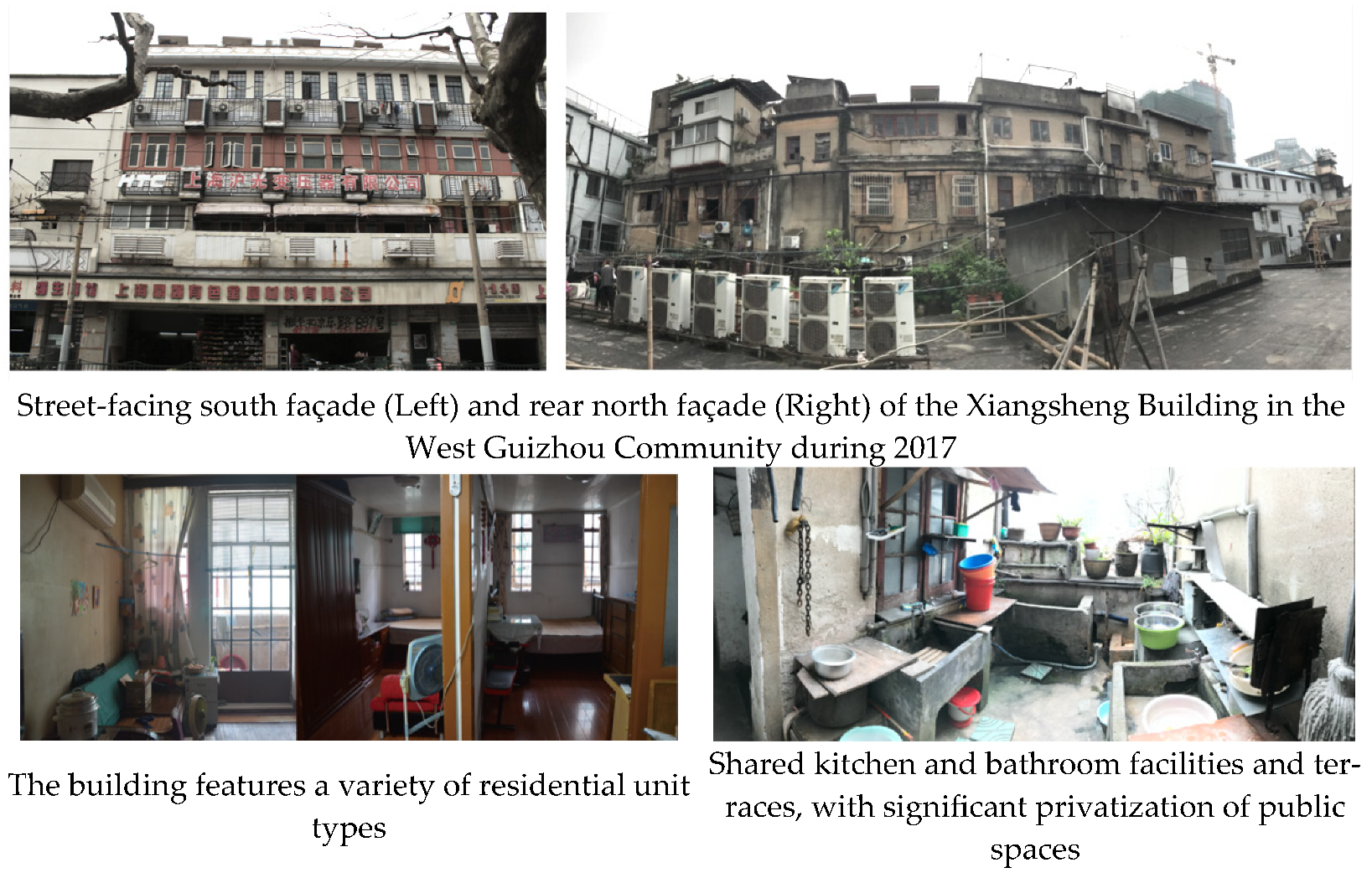
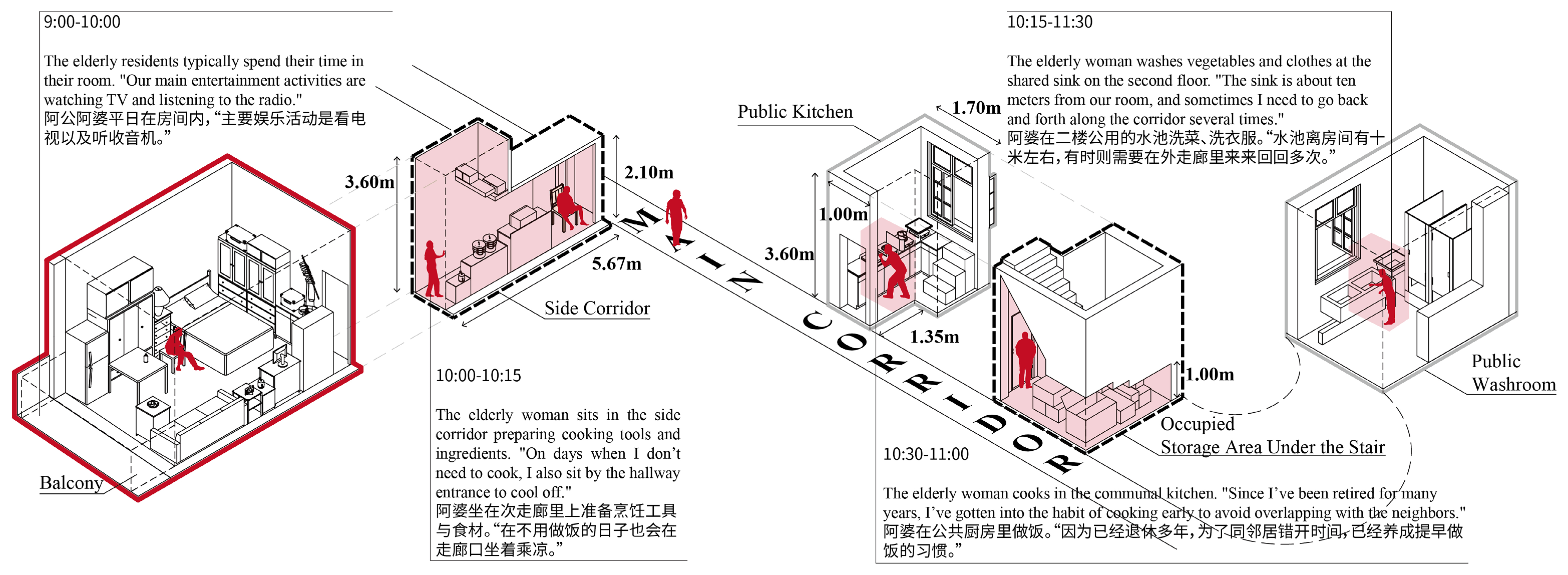
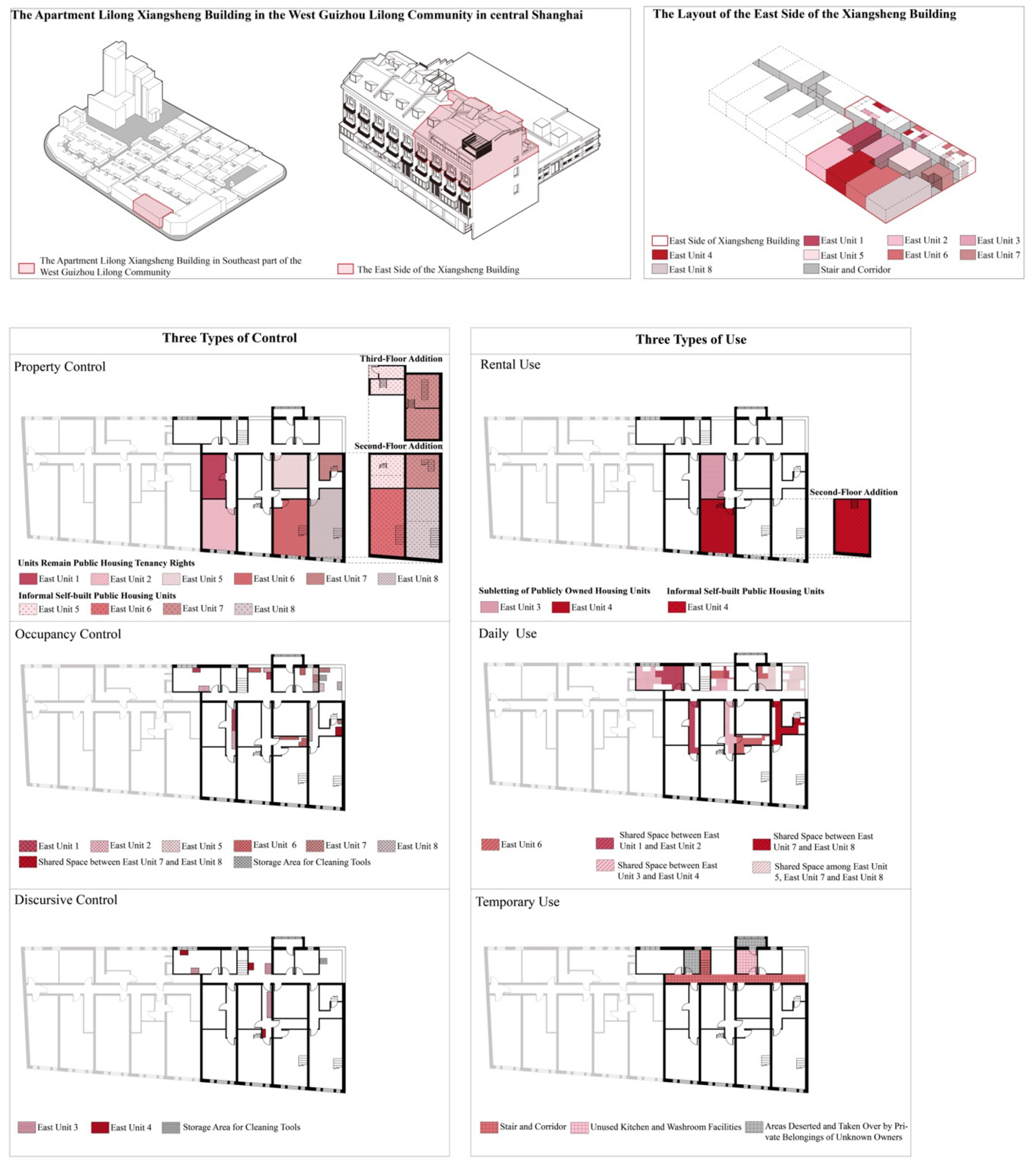
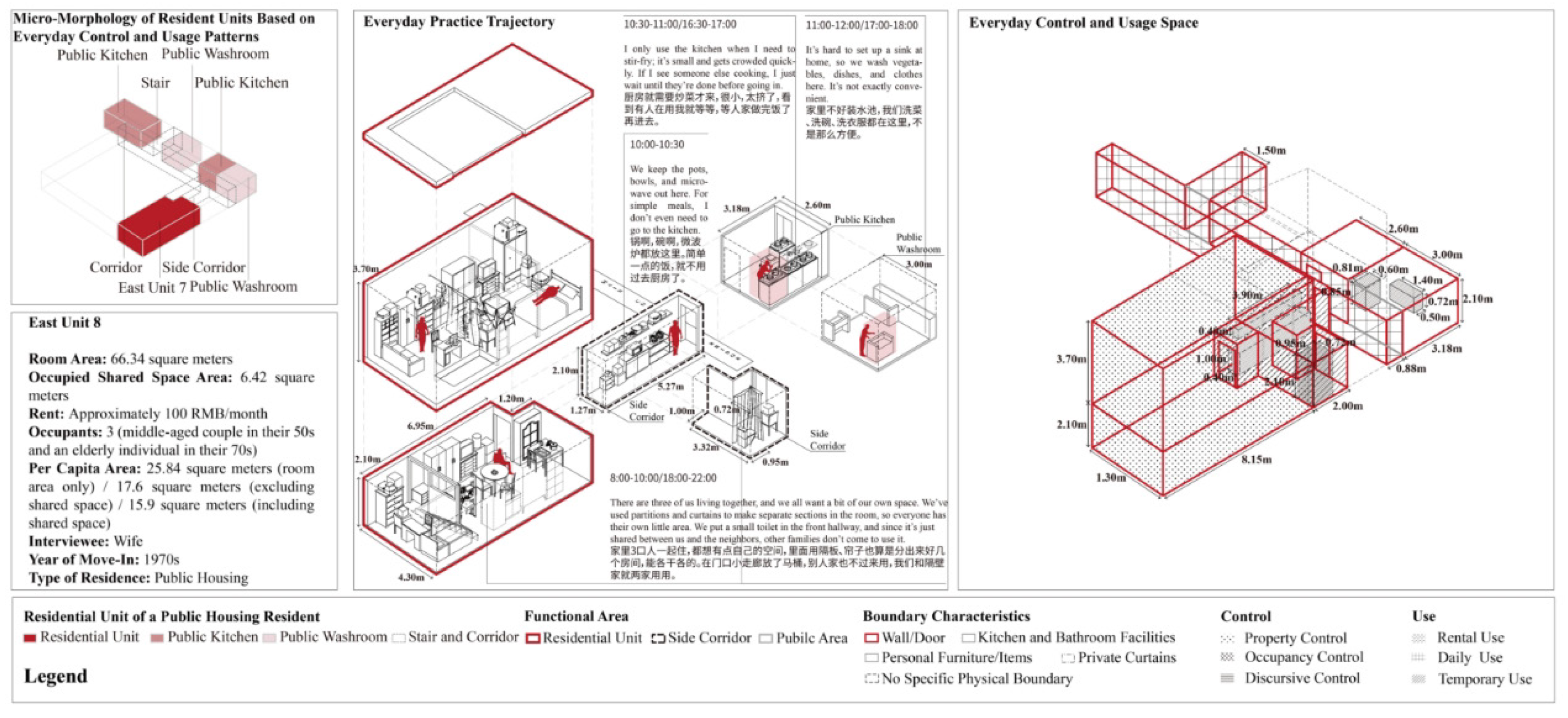

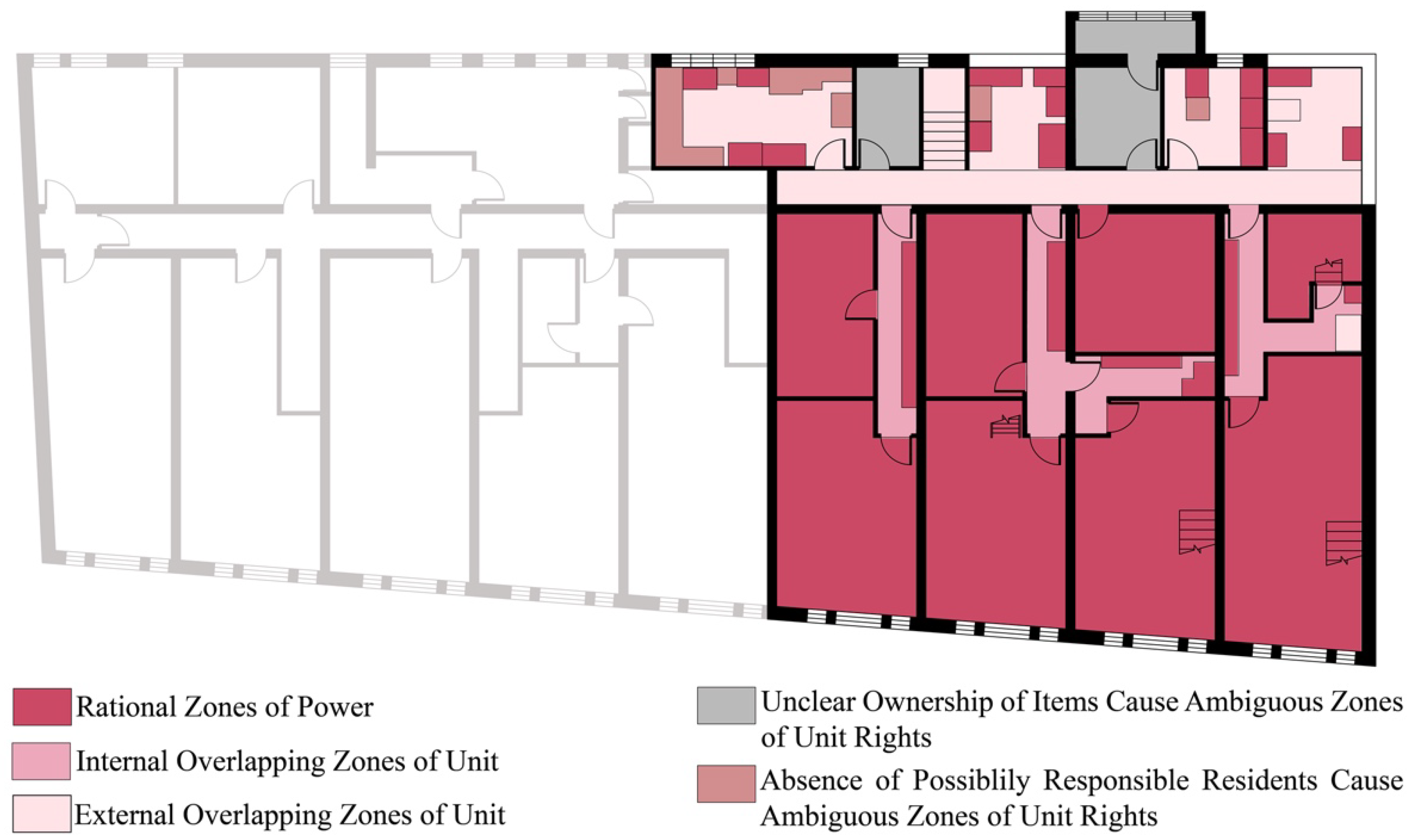
| Resident Groups | Primary Interview Format |
|---|---|
| First-generation | Typically conducted in communal areas or their units, with little engagement from others. |
| Second-generation | More often conducted in shared spaces like laundry rooms or kitchens, where neighbors frequently join; private interviews occur only after trust is built. |
| Tenants | Usually conducted inside their units, as they feel less comfortable in public spaces. |
Disclaimer/Publisher’s Note: The statements, opinions and data contained in all publications are solely those of the individual author(s) and contributor(s) and not of MDPI and/or the editor(s). MDPI and/or the editor(s) disclaim responsibility for any injury to people or property resulting from any ideas, methods, instructions or products referred to in the content. |
© 2025 by the author. Licensee MDPI, Basel, Switzerland. This article is an open access article distributed under the terms and conditions of the Creative Commons Attribution (CC BY) license (https://creativecommons.org/licenses/by/4.0/).
Share and Cite
Zhai, Y. Resident-Centered Narrative Mapping for Micro-Morphological Analysis: Case of a Marginalized Lilong Compound in Downtown Shanghai. Land 2025, 14, 609. https://doi.org/10.3390/land14030609
Zhai Y. Resident-Centered Narrative Mapping for Micro-Morphological Analysis: Case of a Marginalized Lilong Compound in Downtown Shanghai. Land. 2025; 14(3):609. https://doi.org/10.3390/land14030609
Chicago/Turabian StyleZhai, Yuqi. 2025. "Resident-Centered Narrative Mapping for Micro-Morphological Analysis: Case of a Marginalized Lilong Compound in Downtown Shanghai" Land 14, no. 3: 609. https://doi.org/10.3390/land14030609
APA StyleZhai, Y. (2025). Resident-Centered Narrative Mapping for Micro-Morphological Analysis: Case of a Marginalized Lilong Compound in Downtown Shanghai. Land, 14(3), 609. https://doi.org/10.3390/land14030609





